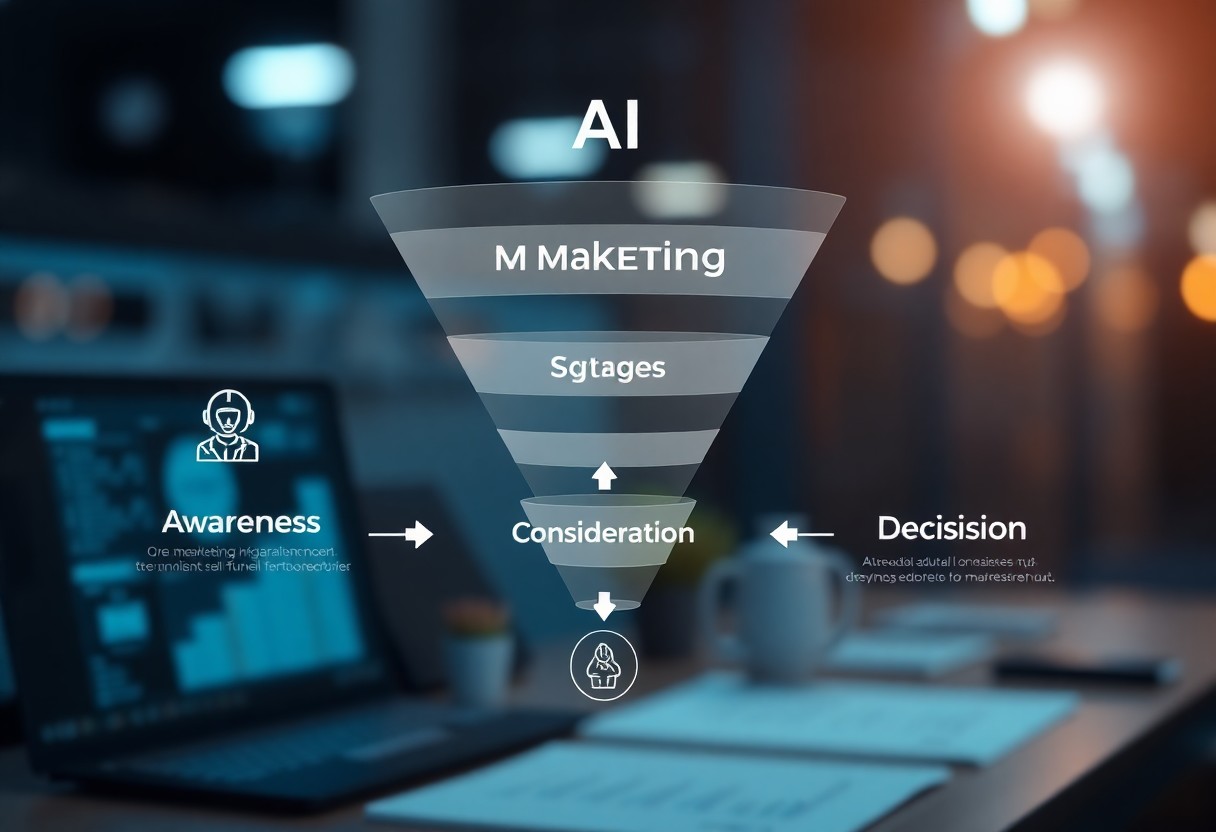
The 3 Stages of an AI Marketing Funnel – A Guide for SMBs.
AI is transforming the landscape of marketing for small and medium-sized businesses (SMBs), and understanding its application within your marketing funnel can significantly enhance your strategy. In this guide, you will discover the three vital stages of an AI-driven marketing funnel: awareness, consideration, and conversion. By mastering these stages, you can leverage AI tools to better engage your target audience, optimize your marketing efforts, and ultimately drive growth for your business. Let’s look into how you can implement these stages effectively.
Mapping Customer Journeys Through AI Algorithms
By implementing AI algorithms, you can effectively map the intricate pathways your customers take, helping you gain insights into their behaviors and preferences. These algorithms analyze large volumes of data to identify patterns and trends, allowing you to understand the different stages of a customer’s journey. With this information, you can personalize your marketing efforts, enhancing customer experience and increasing conversion rates as you address their needs at each touchpoint.
Uncovering Customer Needs with Data
Data-driven insights reveal vital customer needs that might otherwise go unnoticed. You can aggregate data from diverse sources such as website visits, social media interactions, and purchase history to form a comprehensive picture of your audience. By applying AI to this data, you gain access to predictive analytics that highlight customer preferences and pain points, empowering you to tailor your offerings accordingly.
Creating Targeted Segments for Engagement
Segmentation becomes more precise with AI, allowing you to engage customers more effectively. Utilizing algorithms to analyze customer data, you can create highly targeted segments based on demographics, behaviors, and preferences. This refined targeting increases your marketing efficiency, ensuring that your message resonates with the right audience. With AI’s ability to cluster customers into meaningful segments, you can craft personalized campaigns that drive engagement and foster loyalty.
Creating targeted segments involves not just demographics, but also behavioral data and psychographics. For instance, you might find that consumers who frequently purchase eco-friendly products engage differently from those who focus on discounts. AI can identify these nuances, allowing you to tailor your communication strategies—such as offering green options to one group while promoting special sales to another. Embracing these granular insights ensures your marketing messages are not just heard but inspire action from your audience, driving improved engagement and conversions.
Crafting Compelling Content for Every Stage
Creating targeted content that resonates with potential customers at each stage of the funnel ensures effective engagement and conversion. In the awareness stage, you want to capture attention, while the consideration stage focuses on nurturing relationships. Finally, the decision stage is all about facilitating informed choices. Each piece you create should cater to the specific needs and questions of your audience, transforming passive readers into active participants in your brand’s story.
Producing Awareness-Driving Assets
Your aim at the awareness stage is to create content that captures attention and generates interest. Blog posts, infographics, and social media content serve as excellent tools to reach potential customers. Consider employing eye-catching headlines and shareable visuals that provoke curiosity. For instance, an engaging infographic detailing industry trends can easily be shared across platforms, helping you reach a broader audience.
Building Trust with Value-Added Information
Providing valuable, informative content establishes your brand as a trustworthy authority. This stage involves offering resources like webinars, whitepapers, and comprehensive guides that not only educate but also solve specific problems faced by your target audience. By addressing their pain points and offering actionable insights, you cultivate a strong relationship built on trust. The more relatable, insightful, and helpful your content is, the more potential customers will view your brand as a go-to resource in your industry.
You might consider launching a series of free webinars that examine into common industry challenges. By bringing in expert speakers and allowing for Q&A sessions, you’re not just providing information; you’re actively engaging with your audience. Follow this up with well-researched whitepapers that supplement the discussions. These resources can be gated, requiring users to provide their email address, which helps you build your contact list while simultaneously providing value and establishing trust in your brand’s expertise.

Automating Touchpoints: Seamless Customer Interactions
Efficiently automating touchpoints transforms the customer experience by ensuring consistent and timely engagements. By integrating various marketing automation tools, you can engage with prospects seamlessly across multiple channels, such as email, social media, or chatbots. This not only streamlines interactions but also enhances customer satisfaction, as they receive real-time responses and personalized content without delay.
Leveraging AI Tools for Personalization
Using AI tools enables you to deliver highly personalized experiences that cater specifically to individual preferences. By analyzing customer data, AI can tailor messaging, product recommendations, and content delivery, making your communications more relevant and engaging. For example, AI-powered email campaigns can adapt to user behavior, leading to improved open and conversion rates.
Timing Your Interventions for Maximum Impact
Strategically timing your interventions plays a vital role in capturing customer attention. Leveraging AI, you can analyze user behaviors and interactions to pinpoint the best moments to engage, ensuring your messages land when they’re most likely to resonate. This proactive approach not only increases the likelihood of conversion but also enhances overall customer satisfaction by preventing intrusive or poorly timed interactions.
For instance, analyzing historical data might reveal that users are more likely to engage with marketing content in the early evening or on weekends, allowing you to time your email blasts accordingly. By implementing predictive analytics, companies like Amazon have significantly increased their conversion rates by understanding when to present upsell opportunities. By being attuned to customer behaviors, you can optimize engagement and ensure your marketing efforts yield the best results.
Analyzing Results: The Feedback Loop of Improvement
Analyzing results is the backbone of optimizing your AI-driven marketing funnel. You need to regularly track and assess your campaigns to identify what works and what doesn’t. This iterative process, often referred to as the feedback loop, ensures that data informs your future strategies, ultimately driving better results and ROI for your business.
Measuring Engagement Metrics Effectively
Engagement metrics offer a wealth of insight into how your audience interacts with your content. Track key performance indicators such as click-through rates, time spent on page, and social media shares to paint a detailed picture of engagement. Using tools like Google Analytics and social media insights will help you gather this data efficiently, enabling you to identify strong-performing areas and opportunities for growth.
Adapting Strategies Based on Data Insights
Implementing changes based on data insights can significantly enhance your marketing strategies. You should take a deeper look into your analytics to uncover shifting trends, preferences, and behaviors of your audience. By segmenting your audience and understanding their unique profiles, you can tailor content, adjust messaging, or explore new channels that resonate better with your target demographic.
For instance, if data reveals a significant drop-off in engagement on specific content types, you can pivot your strategy to focus on formats that keep your audience invested, such as interactive videos or infographics. Additionally, A/B testing different variations of your campaigns helps you identify which elements resonate best, enabling continuous refinement. Ultimately, adapting based on insightful analysis allows you to make informed decisions that will enhance your marketing effectiveness and strengthen customer relationships over time.
Beyond Sales: Fostering Long-Term Relationships
Your marketing efforts shouldn’t end with a sale. Building long-term relationships with customers enhances loyalty, increases lifetime value, and turns clients into brand advocates. By focusing on their needs and preferences, you can create opportunities for upselling, cross-selling, and generating repeat business. Implementing an AI-driven approach can help personalize experiences and keep customers engaged long after they make their initial purchase.
Nurturing Leads into Loyal Advocates
Nurturing leads involves consistently delivering value and communication that resonates with your audience. Utilize personalized messages, relevant content, and exclusive offers to maintain interest. Treating your customers as partners in their journey fosters trust and encourages them to advocate for your brand. Strategies such as loyalty programs or referral incentives can significantly increase their engagement and satisfaction.
Utilizing AI for Continued Customer Engagement
AI technologies can streamline your ongoing customer engagement strategies. Personalized emails, chatbots, and tailored recommendations are just a few ways AI can keep your audience connected. By analyzing customer data, AI can predict buying behavior and preferences, enabling you to craft predictive outreach that anticipates needs rather than just responding reactively. These initiatives not only nurture relationships but also foster a sense of community around your brand.
For instance, using AI-driven marketing tools, you can track customer interactions and automate responses based on their behaviors. Platforms like HubSpot and ActiveCampaign offer personalization at scale, sending timely content or reminders based on prior purchases or browsing activities. By integrating these AI solutions, you reinforce customer loyalty through meaningful communication that keeps your brand top-of-mind. This proactive stance can turn satisfied customers into enthusiastic promoters, amplifying your reach and visibility within their networks.
Summing up
Conclusively, understanding the 3 stages of an AI marketing funnel is vital for optimizing your business strategies. By effectively guiding your customers from awareness to consideration and finally, to conversion, you can leverage AI to enhance engagement and drive sales. Implementing tailored AI solutions at each stage allows you to maximize the potential of your marketing efforts, ensuring you meet your customers’ needs more efficiently. Embrace these strategies to unlock new growth opportunities and stay ahead in the competitive landscape of SMBs.


